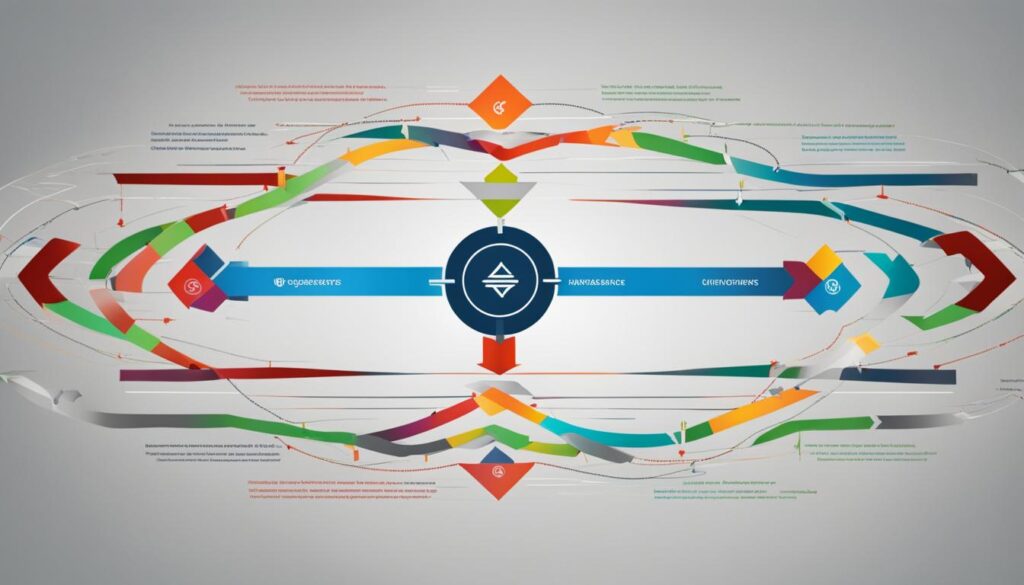Welcome to our blog! Today, we will delve into the world of software quality assurance (SQA) and its vital role in improving your tech solutions. With technology evolving rapidly, it is crucial for companies to ensure that their applications are reliable and meet user needs. The key to achieving this goal is by implementing efficient QA testing methods.
Software quality assurance is a methodology that ensures the quality of a software product complies with a predetermined set of standards. It plays a vital role in the software development life cycle, ensuring that the software works as intended and delivers an outstanding user experience. By prioritizing software quality, businesses can earn market share, trust, and reputation.
Key Takeaways:
- Software quality assurance (SQA) ensures that software products meet predefined standards.
- Implementing effective QA testing methods enhances reliability and performance.
- Software quality assurance is essential for business success and customer satisfaction.
- Continuous improvement is crucial in the software quality assurance process.
- Choosing the right development partner with a strong commitment to quality assurance is vital.
The Importance of Software Quality Assurance
Quality assurance plays a vital role in today’s ever-changing technology industry. It goes beyond simply fixing defects and encompasses a comprehensive approach to ensuring software quality. At our company, we understand the significance of prioritizing quality throughout the software development lifecycle.
By placing a strong emphasis on software quality, businesses can earn a competitive edge, build trust with customers, and establish a solid reputation in the industry. Our commitment to quality assurance ensures that the software we develop meets predefined standards, both internally and externally, resulting in an exceptional user experience.
Thorough testing is a cornerstone of our quality assurance process. We employ meticulous attention to detail, carefully analyzing every aspect of the software to identify potential issues and ensure optimal performance. Additionally, continuous improvement is ingrained in our approach. We constantly evaluate our processes, technologies, and methodologies to stay at the forefront of software quality techniques.
“Quality is not an act, it is a habit.” – Aristotle
By implementing effective quality assurance practices, we strive to eliminate defects, reduce the risk of failure, and deliver software solutions that meet the highest standards. Our dedication to software quality translates into tangible benefits for our clients, including increased customer satisfaction, enhanced reliability, and improved software performance.

| Benefits of Software Quality Assurance | The Importance of Software Quality Assurance |
|---|---|
| Earn market share | Ensure exceptional user experience |
| Build trust and reputation | Prioritize software quality in the development lifecycle |
| Increase customer satisfaction | Thorough testing and attention to detail |
| Reduce defects and failures | Continuous improvement |
| Enhance software performance |
At our company, we understand that software quality assurance is not just a checkbox. It is a mindset that drives our commitment to delivering flawless tech solutions. By partnering with us, you can rest assured that your software will meet the highest quality standards and exceed customer expectations.
The Principles of Software Quality Assurance
Implementing software quality assurance (SQA) successfully requires following certain principles that encompass defect prevention, continuous improvement, stakeholder involvement, and a risk-based approach. By adhering to these principles, businesses can ensure a robust and effective quality assurance (QA) process, driving the development of high-quality software products that meet both internal and external standards.
Defect prevention: The first principle of SQA is to focus on preventing defects rather than just detecting and fixing them. This involves analyzing potential risks early in the development process, implementing proper coding practices, and conducting thorough inspections and reviews to catch issues before they manifest.
Continuous improvement: The second principle emphasizes the importance of continually monitoring and improving the quality of software products. This involves implementing feedback loops, collecting and analyzing data, and making necessary adjustments to optimize the QA process. By embracing a culture of continuous improvement, businesses can stay ahead of emerging challenges and enhance their software quality.
Continuous improvement is not about being perfect, but about getting better every day.
Stakeholder involvement: Encouraging stakeholder involvement is essential for successful SQA. By actively engaging stakeholders throughout the development process, businesses can gather valuable insights, align expectations, and ensure that the software product meets all relevant requirements and user needs. Involving stakeholders also promotes transparency and fosters a sense of ownership and collaboration.
Risk-based approach: Lastly, businesses should adopt a risk-based approach when implementing SQA. This involves identifying and prioritizing potential risks and conducting targeted testing and validation activities accordingly. By addressing high-risk areas first, businesses can allocate their QA resources effectively and focus on mitigating the most critical issues that could impact the software’s performance and reliability.
Implementing these principles ensures a comprehensive and systematic QA process that upholds software quality standards. By practicing defect prevention, pursuing continuous improvement, involving stakeholders, and prioritizing risks, businesses can deliver software products that meet or exceed customer expectations, enhance user satisfaction, and maintain a competitive edge in the market.

| Principles of SQA | Description |
|---|---|
| Defect prevention | Focusing on preventing defects through early analysis, proper coding practices, and inspections. |
| Continuous improvement | Constantly monitoring and enhancing the software quality through feedback loops and data-driven optimizations. |
| Stakeholder involvement | Engaging stakeholders throughout the development process to gather insights and align requirements. |
| Risk-based approach | Identifying and prioritizing risks, conducting targeted testing, and mitigating critical issues. |
Implementing Software Quality Assurance
Implementing software quality assurance (SQA) is crucial for businesses to ensure that their software products meet the highest quality standards. By following a systematic approach, businesses can effectively implement SQA and deliver reliable and high-performing software solutions.
Defining Quality Standards
Defining clear quality standards is the first step in implementing SQA. These standards serve as benchmarks against which the software’s performance, functionality, and reliability will be assessed. By establishing quality standards, businesses can ensure that their software meets the requirements of both the organization and its customers.
Planning SQA Activities
Planning is essential to ensure the successful implementation of SQA. Businesses should develop a comprehensive plan that outlines the key activities, milestones, and resources required for effective quality assurance. This plan should address areas such as testing methodologies, test environments, and the allocation of resources to different testing phases.
Conducting Reviews
A critical aspect of implementing SQA is conducting reviews throughout the software development lifecycle. Expert reviews, such as code reviews and design reviews, help identify potential issues early on and allow for timely corrective actions. By involving domain experts and experienced professionals in the review process, businesses can maximize the effectiveness of their SQA efforts.
Performing Testing
Comprehensive testing is a fundamental component of SQA. Businesses should conduct various types of testing, including functional testing, performance testing, security testing, and user acceptance testing. Testing should be systematic, well-documented, and cover all critical aspects of the software to ensure its reliability and quality.
Monitoring and Measuring Quality
Continuous monitoring and measurement of the software’s quality are essential throughout the development process. By tracking key quality metrics, businesses can identify any deviations from the defined standards and take corrective actions promptly. This enables businesses to improve the quality of their software products and deliver a superior user experience.

Implementing software quality assurance requires a commitment to setting clear standards, planning and executing SQA activities, conducting reviews, performing comprehensive testing, and monitoring and measuring quality. By following these best practices, businesses can ensure the successful implementation of SQA and deliver software solutions that meet the highest quality standards.
Different Approaches to Software Quality Assurance
When it comes to software quality assurance, businesses have various approaches to choose from based on their software development process. Each approach offers unique benefits and caters to different project requirements and goals. In this section, we will explore three popular software quality assurance approaches: the traditional approach, Agile approach, and DevOps approach. We will also touch upon other notable approaches such as Six Sigma, Lean, CI/CD, and TDD.
The Traditional Approach
The traditional approach to software quality assurance follows a sequential process. It involves detailed planning, designing, and documenting the entire project before commencing development. Testing is conducted at the end of the development cycle, focusing on identifying defects and ensuring adherence to predefined standards. While this approach provides structure and documentation, it may not cater well to rapidly changing project requirements or time-sensitive projects.
The Agile Approach
The Agile approach to software quality assurance is characterized by collaboration, flexibility, and incremental development. It emphasizes customer satisfaction, adaptive planning, and self-organizing teams. Through iterative cycles known as sprints, development and testing activities are carried out simultaneously, allowing for rapid feedback and continuous improvement. The Agile approach enables businesses to quickly respond to changes and deliver high-quality software that aligns with evolving customer needs.
The DevOps Approach
The DevOps approach combines development and IT operations, promoting close collaboration throughout the software development lifecycle. It aims to bridge the gap between development and deployment, ensuring quick and efficient delivery of software products. The DevOps approach emphasizes automation, continuous integration, and continuous delivery, enabling faster release cycles and improved product quality. By integrating development and operations seamlessly, businesses can achieve faster time-to-market and enhanced customer satisfaction.
“The traditional approach provides structure, while Agile and DevOps offer flexibility and speed. Choosing the right approach depends on the project’s requirements and goals.”
In addition to the traditional, Agile, and DevOps approaches, there are other notable methods businesses can consider. Six Sigma focuses on eliminating defects and minimizing variations, Lean aims to reduce waste and increase efficiency, CI/CD (Continuous Integration and Continuous Delivery) ensures rapid and frequent releases, and TDD (Test-Driven Development) emphasizes writing tests before coding. Each of these approaches brings its own unique advantages and can be leveraged based on the specific needs of a project.
By carefully evaluating the project requirements, goals, and constraints, businesses can determine the most suitable approach to software quality assurance. Whether it’s the sequential nature of the traditional approach, the flexibility of Agile, the efficiency of DevOps, or the specific methodologies like Six Sigma, Lean, CI/CD, or TDD, the chosen approach should align with the desired outcomes and contribute to the successful delivery of high-quality software products.

| Approach | Description |
|---|---|
| Traditional Approach | Sequential process with detailed planning and testing at the end of the development cycle. |
| Agile Approach | Collaborative, flexible approach with iterative cycles, allowing for rapid feedback and continuous improvement. |
| DevOps Approach | Combines development and IT operations, emphasizing automation, continuous integration, and continuous delivery. |
| Six Sigma | Focuses on eliminating defects and minimizing variations in processes. |
| Lean | Aims to reduce waste and increase efficiency in software development. |
| CI/CD | Ensures rapid and frequent releases through continuous integration and continuous delivery. |
| TDD | Test-driven development approach, emphasizing writing tests before coding. |
Choosing the Right Development Partner
When embarking on a tech journey, it is crucial to choose a development partner who demonstrates a strong commitment to quality assurance. At [Development Partner Name], we understand the importance of delivering high-quality software products that meet customer expectations. Our QA process is built on industry best practices and rigorous testing methodologies to ensure the reliability and performance of your applications.
Our track record speaks for itself. Over the years, we have successfully implemented robust QA processes, incorporating thorough testing and continuous enhancement. We believe in the power of quality assurance practices to drive measurable success for our clients.
When selecting a development partner, it is essential to evaluate their overall capabilities, project management approach, communication channels, and client satisfaction. These factors contribute to a successful and productive partnership. At [Development Partner Name], we take pride in our ability to deliver tangible business value through our QA practices and solidify our commitment to your success.
The Benefits of Choosing [Development Partner Name]
- Robust QA Process: Our QA process ensures that your software product meets the highest quality standards.
- Thorough Testing: We conduct comprehensive testing to identify and address any potential issues or defects.
- Continuous Enhancement: We continually improve our QA practices to stay at the forefront of industry trends and technological advancements.
- Efficient Project Management: Our project management approach ensures timely delivery and effective collaboration throughout the development process.
- Effective Communication: We prioritize clear and open communication to keep you informed and involved in the project every step of the way.
- Client Satisfaction: Our focus on client satisfaction drives our commitment to delivering exceptional software solutions that exceed expectations.
Choosing the right development partner is a crucial step in achieving a successful tech journey. Let [Development Partner Name] be your trusted partner in transforming your ideas into reliable and high-performing software solutions. Experience the difference of working with a team that places a premium on quality assurance and takes pride in driving your business forward.

“We take pride in our ability to deliver tangible business value through our QA practices and solidify our commitment to your success.”
Technical Expertise in Quality Assurance
In software quality assurance, technical expertise plays a vital role in ensuring the success of our projects. At [Development Partner], we understand the importance of staying up-to-date with the latest testing frameworks and tools to deliver exceptional results.
Our team possesses a deep understanding of industry-standard testing frameworks, enabling us to provide comprehensive test coverage and identify potential issues early in the development process. We have extensive experience in utilizing automation testing, performance testing, security testing, and accessibility testing to deliver robust and reliable software products.
Automation testing allows us to streamline the testing process, increase efficiency, and accelerate the time-to-market of our clients’ applications. By leveraging automation frameworks such as Selenium, Appium, and Cypress, we ensure accurate and repetitive testing, minimizing human error and improving overall product quality.
Additionally, our technical expertise extends to performance testing, where we assess the responsiveness, scalability, and stability of software applications under different load conditions. Security testing is another integral component of our QA process, where we identify vulnerabilities and ensure the confidentiality, integrity, and availability of sensitive data.
Furthermore, our accessibility testing capabilities ensure that software products adhere to accessibility standards, making them usable and inclusive for people with disabilities. We conduct comprehensive testing to ensure compliance with WCAG guidelines and strive to create inclusive digital experiences for all users.
Partnering with [Development Partner] means benefiting from our technical expertise in testing frameworks and our commitment to delivering impeccable quality assurance services. Our proficiency in leveraging industry-standard tools and methodologies guarantees efficient bug detection, optimal product performance, and exceptional user experiences.
Our Technical Expertise Highlights:
- Proficiency in industry-standard testing frameworks and tools
- Automation testing using Selenium, Appium, and Cypress
- Performance testing for responsiveness, scalability, and stability
- Security testing to ensure confidentiality and integrity
- Accessibility testing for inclusive digital experiences
By partnering with [Development Partner], you gain access to our technical expertise in quality assurance, ensuring the delivery of high-quality software products that meet the highest standards and exceed customer expectations.
Benefits of Software Quality Assurance
Implementing software quality assurance (SQA) offers a wide range of benefits for businesses. By prioritizing quality, we can deliver reliable software products, ensuring customer satisfaction and building trust. With an effective SQA process in place, we can reduce defects and errors, improving the overall efficiency and productivity of our software development. This ultimately saves costs and enhances the quality of the final product. Quality assurance is a crucial factor in achieving long-term success and setting ourselves apart in the fiercely competitive tech landscape.
Delivering Reliable Software Products
By implementing SQA, we can ensure that our software products function as intended, meeting the highest quality standards. Thorough testing and attention to detail eliminate potential errors or malfunctions, delivering reliable and consistent performance to our users. This reliability builds trust and enhances our reputation in the market.
Ensuring Customer Satisfaction
Customer satisfaction is a top priority for any business. With SQA, we can identify and address customer pain points, ensuring that our software meets their needs and expectations. By listening to customer feedback and continually improving our products, we can enhance user experiences and foster long-term customer loyalty.
Reducing Defects and Errors
SQA focuses on preventive measures to identify and eliminate defects and errors early in the development process. By conducting rigorous testing and implementing quality control measures, we can proactively identify potential issues and rectify them before they impact the end-users. This reduces the number of post-release bugs and enhances the overall quality of the software.
Improving Efficiency and Productivity
A well-executed SQA process streamlines development workflows, eliminates redundant processes, and promotes efficient collaboration among team members. By following standardized quality assurance practices, we can optimize resource utilization, reduce time wastage, and ensure that our development efforts are aligned with business objectives.
Saving Costs
Implementing SQA helps us identify and rectify defects earlier in the development life cycle, which ultimately saves costs associated with addressing issues in later stages. By minimizing the need for extensive bug fixes and reducing post-release support, we can allocate our resources more effectively, resulting in cost savings for the business.
Enhancing the Overall Quality of the Software Development Process
Quality assurance is not just about the end product; it encompasses the entire software development process. By implementing SQA, we establish a culture of continuous improvement, constantly refining our development practices, and delivering higher-quality software. This improves team collaboration, fosters innovation, and ensures that our products meet industry standards and best practices.
Quality assurance is a cornerstone of successful software development. By embracing SQA, we can deliver reliable, high-quality software solutions that delight our customers, drive customer satisfaction, and empower our business to thrive in the competitive tech landscape.
Continuous Improvement in Software Quality Assurance
In the world of software quality assurance, continuous improvement is a vital aspect that drives the success of our products. At [Company Name], we understand the importance of monitoring and measuring the quality of our software throughout the development process. By analyzing metrics, tracking defects, and conducting root cause analysis, we can identify areas for improvement and make necessary changes to our SQA process.
Continuous improvement allows us to enhance the quality of our software products and stay ahead of the competition. It enables us to deliver reliable and high-performing applications that exceed customer expectations. By constantly striving for excellence, we ensure that our software meets the highest standards of quality.
As part of our continuous improvement efforts, we prioritize collaboration and feedback from all stakeholders involved in the software development process. This ensures that we address any potential issues early on and incorporate valuable insights into our SQA process.
The Benefits of Continuous Improvement
Implementing continuous improvement practices in our SQA process offers several key benefits:
- Enhanced Quality: By identifying and addressing areas for improvement, we can enhance the overall quality of our software products.
- Increased Efficiency: Continuous improvement allows us to streamline processes, optimize workflows, and improve overall efficiency.
- Reduced Risks: By continuously monitoring and analyzing data, we can proactively identify and mitigate risks in the software development process.
- Improved Customer Satisfaction: Consistently enhancing our software products ensures that we deliver solutions that meet and exceed customer expectations.
At [Company Name], continuous improvement is ingrained in our software quality assurance culture. It is a driving force behind everything we do, ensuring that we deliver exceptional software solutions that empower our clients and propel their success.
| Benefits of Continuous Improvement | Description |
|---|---|
| Enhanced Quality | Identification and addressing of areas for improvement leading to enhanced software quality. |
| Increased Efficiency | Streamlined processes, optimized workflows, and improved overall efficiency. |
| Reduced Risks | Proactive identification and mitigation of risks in the software development process. |
| Improved Customer Satisfaction | Consistently delivering software solutions that exceed customer expectations. |
Our Commitment to Continuous Improvement
“Continuous improvement is not just a process; it is a mindset. At [Company Name], we embrace this mindset in our software quality assurance practices. By constantly analyzing, refining, and adapting, we ensure that every software product we deliver is of the highest quality.”
Through analyzing data, gathering feedback, and leveraging industry best practices, we continuously enhance our SQA process to stay at the forefront of technological advancements. Our commitment to continuous improvement is what sets us apart and drives our unwavering dedication to deliver flawless software solutions.
By embracing continuous improvement in our SQA process, we empower our teams to innovate, evolve, and create software solutions that create lasting value for our clients. At [Company Name], we are committed to raising the bar and setting new standards for excellence in software quality assurance.
Differences Between Software Testing, Quality Assurance, and Quality Control
To ensure the delivery of high-quality software products, it is essential to understand the distinctions between software testing, quality assurance, and quality control. Each process plays a crucial role in the software development lifecycle, contributing to the overall quality and reliability of the final product.
Software Testing:
Software testing is a critical aspect of the development process. It involves systematically evaluating software to identify defects, errors, and potential issues. By conducting various testing techniques, such as functional testing, performance testing, and user acceptance testing, we can ensure that the software meets the expected standards of functionality, performance, and user experience.
Quality Assurance:
Quality assurance (QA) focuses on ensuring that the development process adheres to a set of predefined standards and best practices. It aims to prevent defects and errors by implementing rigorous processes, methodologies, and quality control checks. QA involves creating and implementing quality management systems, conducting audits, and establishing quality metrics to measure the effectiveness of the development process.
Quality Control:
Quality control (QC) involves inspecting and evaluating the software product to ensure that it meets the specified quality requirements. It includes activities such as product inspection, testing, and verification to identify and rectify any non-conformities. Quality control measures are implemented at various stages of the development process to guarantee the final product’s compliance with quality standards.
Understanding the Relationship:
Software testing is a sub-process of both quality assurance and quality control. While testing focuses on identifying defects, quality assurance ensures that the development process itself is robust and adheres to established standards. Quality control, on the other hand, verifies the software’s compliance with quality requirements. All three processes are vital components of an effective software development lifecycle, working together to deliver high-quality and reliable software products.
Conclusion:
Software testing, quality assurance, and quality control are integral to achieving excellence in software development. By implementing comprehensive testing practices, adhering to quality standards, and conducting thorough inspections, we can enhance the overall quality, performance, and reliability of software products.
The Future of Software Quality Assurance
The future of software quality assurance looks promising, as technological advancements continue to shape the software development landscape. Embracing new technologies and innovations is key to staying ahead in this rapidly evolving industry. As cloud computing, containerization, microservices, and DevOps practices become more prevalent, businesses must adapt and incorporate these advancements into their quality assurance processes.
Collaborative innovation will play a vital role in driving the future of software quality assurance. By fostering a culture of collaboration and knowledge sharing, we can leverage the collective expertise of professionals in the field to achieve new heights of quality and excellence.
Visionary thinking is also essential in shaping the future of software quality assurance. By envisioning a future where software products are not just reliable, but also intelligent, intuitive, and transformative, we can drive innovation and push the boundaries of what is possible.
To truly unlock the full potential of tech innovations, it is imperative to harness cutting-edge technologies in the field of software quality assurance. From artificial intelligence and machine learning to advanced automation and predictive analytics, these technologies can revolutionize the way we test, analyze, and ensure the quality of software products.
“The future of software quality assurance lies in embracing new technologies and innovations.”
| Innovations | Impact on SQA |
|---|---|
| Cloud Computing | Enables scalable testing environments and improves accessibility |
| Containerization | Facilitates efficient deployment and enhances test environment consistency |
| Microservices | Enables modular and independent testing of software components |
| DevOps Practices | Integrates development and operations, enabling continuous testing and delivery |
These innovations, along with many others, will revolutionize the way we approach and execute software quality assurance. By staying updated, integrating these technologies effectively, and adapting to the changing landscape, we can ensure that the future of software quality assurance is bright and full of possibilities.
Conclusion
Software quality assurance is a fundamental aspect of the software development life cycle. At [Company Name], we understand the significance of prioritizing quality to deliver flawless tech solutions that exceed customer expectations in today’s competitive market. By implementing effective software quality assurance practices, embracing continuous improvement, and collaborating with the right development partner, businesses can elevate their tech performance and achieve long-term success.
Quality engineering is paramount in the rapidly evolving tech landscape. With our holistic approach to quality, we ensure that every aspect of your software product is thoroughly tested and meets your predefined standards. Our team of experienced professionals utilizes industry-standard testing frameworks and tools, including automation testing, performance testing, security testing, and accessibility testing, to ensure robust test coverage, efficient bug detection, and optimal product performance.
By partnering with [Company Name], you can reap the benefits of software quality assurance. Our commitment to delivering reliable software products guarantees customer satisfaction, reduces defects and errors, improves efficiency and productivity, saves costs, and enhances the overall quality of the software development process. Together, we can navigate the dynamic tech landscape, staying at the forefront of software innovations and unlocking the full potential of your tech solutions.
FAQ
What is software quality assurance?
Software quality assurance (SQA) is a methodology to ensure that the quality of the software product complies with a predetermined set of standards.
Why is software quality assurance important?
Quality assurance is essential in today’s ever-changing technology industry. It goes beyond fixing defects and focuses on thorough testing, attention to detail, and continuous improvement.
What are the principles of software quality assurance?
The principles of software quality assurance include defect prevention, continuous improvement, stakeholder involvement, and a risk-based approach.
How can software quality assurance be implemented?
To implement software quality assurance effectively, businesses should define quality standards, plan SQA activities, conduct reviews, perform testing, and monitor and measure the quality of the software product.
What are the different approaches to software quality assurance?
The different approaches to software quality assurance include the traditional approach, Agile approach, DevOps approach, Six Sigma, Lean, CI/CD, and TDD.
How do I choose the right development partner for software quality assurance?
When choosing a development partner, evaluate their track record in implementing robust QA processes, ensuring thorough testing, and consistent enhancement.
How important is technical expertise in quality assurance?
Technical expertise is crucial in software quality assurance to utilize industry-standard testing frameworks and tools, ensuring robust test coverage and optimal product performance.
What are the benefits of software quality assurance?
The benefits of software quality assurance include delivering reliable software products, ensuring customer satisfaction, reducing defects and errors, improving efficiency and productivity, saving costs, and enhancing the overall quality of the software development process.
Why is continuous improvement important in software quality assurance?
Continuous improvement is important in software quality assurance to monitor and measure the quality of the software product, identify areas for improvement, and make necessary changes to the SQA process.
What are the differences between software testing, quality assurance, and quality control?
While software testing focuses on identifying defects and issues within the software, quality assurance ensures that the development process meets predefined standards, and quality control involves the inspection and evaluation of the software to ensure it meets quality requirements.
What is the future of software quality assurance?
The future of software quality assurance lies in embracing new technologies and innovations, collaborative innovation, visionary thinking, and harnessing cutting-edge technologies.









